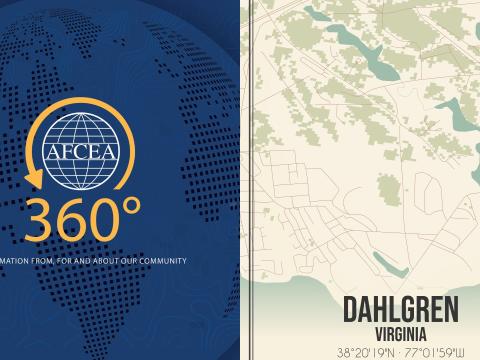Hidden Biases and Artificial Barriers Didn't Stop This Navy Officer
When Rear Adm. Danelle Barrett, USN (Ret.), joined the Navy in 1989, she couldn’t program her VCR. Now she’s proud to say she can program a router. A history major who grew up in Buffalo, New York, and graduated from Boston University, she hoped to escape the cold weather when she joined the Navy.
“I want to live somewhere warm, I don’t even care what the job is,” Adm. Barrett admitted during the Women in the Workforce: A Journey in STEM virtual event. “So it was serendipity that somebody looked out for me and gave me a great job in communications on my first tour.”
She started to get interested in technology at that point “because I was looking at the application of technology not the academics of it,” the admiral said. A hands-on learner who did not enjoy math or science as a kid, she wanted to know how RF communications worked, which progressed to wanting to understand networks and beyond.
Eventually she would serve as director of Current Operations at U.S. Cyber Command, and assumed duties in 2017 as the Navy Cyber Security Division director and deputy chief information officer on the chief of Naval Operations staff.
In her last position in the Navy, she led the Navy’s strategic development and execution of digital and cybersecurity efforts, enterprise information technology improvements and cloud policy, and governance for 700K personnel across a global network. An innovator, she implemented visionary digital transformation to modernize, significantly improving Navy Information Warfare capabilities.
She credits her success to her openness to learning and guidance from mentors. “All through my career I had great mentors…men, women, people who worked for me, people I worked for, people who were not in my field,” she said.
A mom, a navy officer and a technologist, Adm. Barrett had people who were mentors in each of those areas. “I used them to help me through my career and to ask dumb questions. I’m the queen of dumb questions. I have no shame when it comes to asking dumb questions because you know what, I just need to understand, so I can be better,” the admiral said.
Education also played a role in Adm. Barrett’s 30-year career. Getting degrees and certificates are all well and good but she looked for other ways to grow. “I think it’s very important in this STEM field that you keep up with technology,” she said. “You have to be the futurist. You have to be the champion for future technologies and be able to translate those capabilities into something that is a mission impact or a military command or a business impact,” she added.
That learning process of understanding truly what that new technology can do, what the risks are and what the opportunities are will help those in the STEM field make decisions and recommendations to the people they are supporting, said the admiral.
Hidden biases are everywhere. Adm. Barrett acknowledged she’s talked about them before, but that’s because they don’t go away. Biases start at a very young age. Kids are influenced by their family, friends and environment, and also by social media and the toys they play with.
Adm. Barrett discussed the Barbie Doll as an example. “Barbie’s top three jobs up until a few years ago were fairy, princess and mermaid,” she said. “Now, had I known mermaid was an option for a job, I probably would not be your keynote speaker today,” the admiral joked.
Now one can at least find astrophysicist and science Barbie, though the overall physical appearance of the doll is still troublesome.
She also envisions improvements for Mrs. Potato Head. “I want my Mrs. Potato Head not to have earrings, but to have a little chip she can stick in her head to control a UAV. Let’s go there and see what girls can do with that,” she said.
Even within families, we can inadvertently be sending messages about things that are the right way to do things or not, said Adm. Barrett. “If we are sending messages that STEM is not important because we don’t encourage girls to go to STEM events or connect them if you’re not a STEM person with someone who might be, then we aren’t doing enough to expose them so that they can be the next great Marie Curie,” she added.
The future of the STEM workforce can’t be based on one gender or one group of people. “As I went through the Navy, I always wanted to be just known as an officer, not a female officer, not a male officer. I don’t want to be defined by my gender,” said the admiral.
She thinks it’s important to get out of the idea of the “first to.” “I don’t want it to be news that a woman is the first to… it should just be the way it is. You are just great because you are great at your job and not because you are a female,” Adm. Barrett added.
The STEM folks also need to understand they can’t just be STEM, said the admiral. She used her daughter as an example to look towards. “I call her my scientist in a tutu because she got a degree in science while she was a professional ballerina.”
STEM people need to be able to use both sides of their brain. “The best STEM people are the ones who really understand computer design and user interface and how that’s going to work in the future,” the admiral said. “If humans and machines start to merge, I need to understand what that means from an anthropology perspective, from a human perspective. You can have the best technical solution in the world and it will fail if it’s hard to use,” the admiral emphasized.
Adm. Barrett urged the virtual event participants to ignore artificial barriers to STEM. “Go over them, go around them, go through them, and encourage your mentors to do the same. Push them hard. Push them to look at the art of the possible,” she said.
You can hear the full speech and view the entire Women in the Workforce: A Journey in STEM virtual event on demand. Click for more information.




Comments